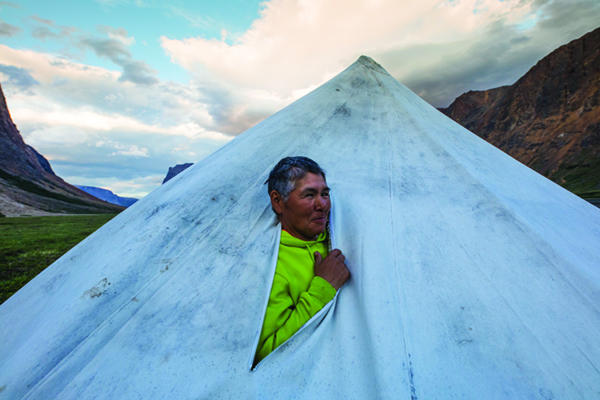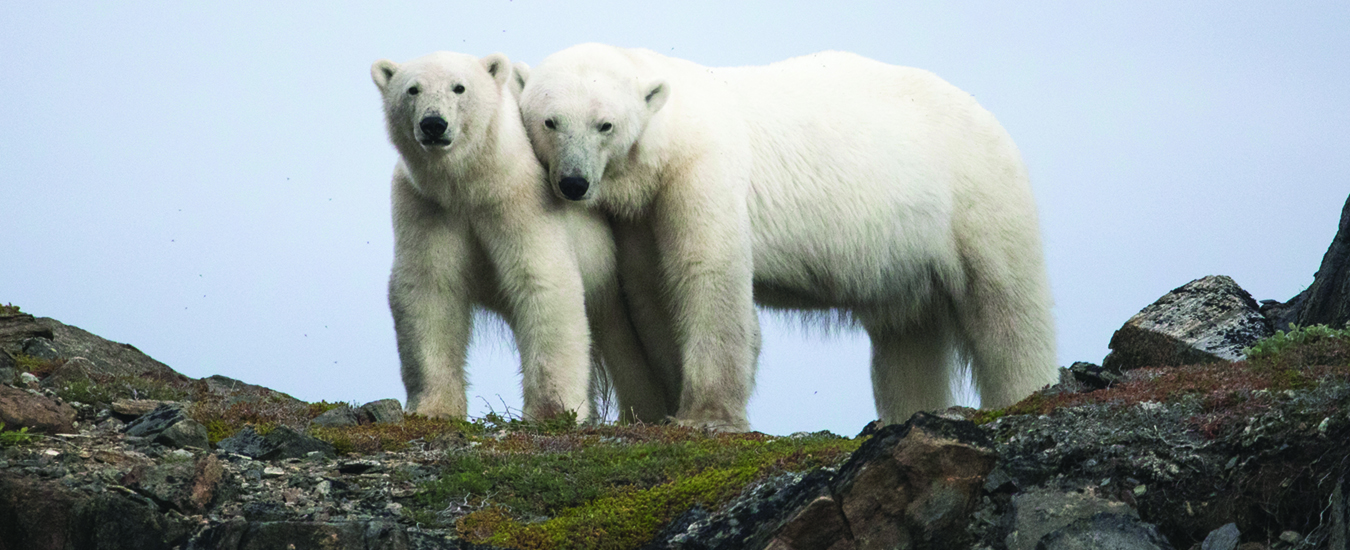Labrador’s Inuit bear guards double as cultural ambassadors.
by Carol Patterson
I watched a speedboat tie up to the gangway, bobbing in the dark blue waters of Torngat Mountains National Park. Several men in camouflage waved at our expedition leader. A red Parks Canada chair was perched atop several backpacks and rifle cases stacked on the boat deck.
I was draped over the damp rail of an expedition cruise ship (One Ocean Expedition’s Akademik Ioffe). Copper-coloured mountains ringed the deep frigid water of Saglek Fjord; scree slopes echoing back the quiet hum of our marine engine.
I’d made it to Labrador and the highest peaks east of the Canadian Rockies, but it would be the people, not scenery, that would make the biggest impression in this unique and illuminating tourism experience.
Perhaps only in Canada’s north is a person happy and relieved to hike while someone with a rifle stands guard. In northern Labrador these armed observers are Inuit guards tasked with preventing close encounters between tourists and bears.
Labrador’s Torngat Mountains National Park is Canada’s only national park owned, managed and operated by Inuit, and that rare place where you might spot both polar and black bears in one day. To keep it from being your final day, Parks Canada recommends hiring a bear guard.
Insurance companies may appreciate that bear guards reduce customer risk, but for the few hundred people who journey to Labrador’s remote east coast, the bear guards are more than safeguards against bear mauling; they may be the only Inuit they meet.
With a deep connection to their land, our minders are soft-spoken, powerful ambassadors for Labrador. Hearing them talking over the radio in Inuktitut provided me a glimpse into a culture thousands of years old.
I’d awoken that morning to reports a polar bear had been spotted off the port side. Throwing a heavy coat over my pajamas I’d scrambled to the deck, startled at how hard it was to make out one of the world’s largest bears, its rapid scramble over the rocky shore about the only thing making it visible. Now, we were going ashore in a land rich with bears.
Our expedition crew and Andrew Andersen, the visitor experience co- ordinator for the park and a bear guard headed to shore with several other guards. Using eyes trained from years on the land to spot wildlife, they made sure there were
no bruins before calling us ashore.
Hearing them talking over the radio in Inuktitut provided me a glimpse into a culture thousands of years old
Our rubber dinghy skipped across the fjord’s north arm, stopping a few metres short of the shoreline. I slipped over the side into knee-deep water. “Put your PFDs there and gather near Andrew,” our expedition leader yelled.
Once assembled, we learned the first rule of hiking with a bear guard—they rule. They rule in that what they say trumps any foolish ideas you may have about exploring on your own. If they tell you to hike single file (all the better to distinguish hikers from bears), you do just that.
“Last year about 230 polar bears were counted from Hebron to here,” Andersen explained, gaining my undivided, jaw-dropped attention; yet helping me relax into the regimented hiking style as I strode past knee-high bushes, and basked in rare sunshine.
With fewer than 1,000 visitors to Torngat Mountains National Park (by contrast, the remote Himalayan kingdom of Bhutan receives 200,000) and no permanent residents, I could see why bears dominate the landscape. What’s less obvious is how important the role of bear guards is to the Inuit. Park superindent Gary Baikie would tell me later, “no one lives (in the park) anymore. Getting back there (as bear guards) makes them feel whole again.”
To be a guard one must have training certification, first aid certification, be authorized to carry a firearm, be an Inuit beneficiary of Nunavik Inuit or Labrador Inuit land claims and have years of experience on the land. Derrick Pottle, who trains many of the bear guards, described the job’s appeal. “Inuit were born to be outdoors. We love being close to nature. It is a golden opportunity to be on the land and to provide a legitimate service.”
The job doesn’t require bear guards to tell stories, but many of them do. Andersen pointed out a simple rock marker on the ground. “This is a grave,” he remarked somberly. “There’s no formal cemetery here so be careful not to step on the stone.”
As we carried on over a hillside, stopping at a waterfall for pictures, Andersen revealed he was from two cultures, with an Australian mother and Inuit father, but he never took his eyes off our group for more than a few seconds.
We waded into a fast-moving stream, Andersen and the other guards constantly scanning the banks for bears hidden in the deep bushes. “Keep together,” he urged, as some of our group stopped for photos, the mindless city-folk craving for “selfies” overtaking self-preservation instincts.
Two hours after leading our group away from the shoreline in this particular junket, Andersen delivered us back, no people or bears injured.
I asked Andersen what he wanted us to remember from our time with him. He murmured, “That we try our best to promote Inuit culture and the remoteness.” I realized it had been days since I’d seen a jet contrail or had a cellphone signal. I was enjoying the former but the latter took some getting used to.
Back on board, I spent my free time lazing in my bunk or listening to stories from ship historian Russell Potter on Inuit culture. It seemed I wasn’t the first to be fascinated. In 1911 the legislature of Newfoundland and Labrador passed an act forbidding the export of native people except to hunt or fish. I was appalled such a law had been necessary, but with Europeans and Americans eager to learn about sealskin-wearing Inuit, promoters lured Inuit to appear at world fairs and expositions. Some were left in strange cities with no funds to return to Labrador.
Now people who come to Labrador hear Inuit stories in a more respectful way. In his bear guard training programs Pottle sees the opportunity for cross-cultural sharing. “Who else better to interpret Inuit culture than the Inuit? Our history was an oral history and we still keep that tradition alive. We have the opportunity to promote our culture.”

Photo credit: Dave Brosha
Jillian Larkham, director of tourism for the government of Nunatsiavut, sees bear guards as logical links between Inuit culture and tourists. “One of the takeaways is telling our story and how our culture is still so rich. (Our) people didn’t think (visitors) would be interested—but they are.”
On the day we stopped in Hebron Mission National Historic Site of Canada (a former Moravian missionary site closed in 1959, forcing Inuit to relocate) heavy skies gave the air a feeling of misery. Gus Semigak greeted our boats, his dark, sun-burnished face creased in a shy smile despite the crumbling buildings framing the harbour.
“I was three when I was relocated to Hopedale,” Semigak recalled, “My parents were very sad. My parents always wanted to go back but they never got to.” Now, Semigak is back in Hebron along with three others, providing bear safety, restoring buildings as a heritage carpenter, and sharing his tales. “My parents talked about Hebron. They told us about the area and the hunting. The people who come on cruise ships are curious. I try to answer questions the way I heard about it (from my ancestors).”
Our group hiked for two hours around muted-coloured rocks that might hide bears. I spotted the bright-orange vest of Seth Tuglavina on a ridge high above us, his rifle held at the ready as he watched us marching over the deep heathery cushion; our thoughts on the scenery—his on predators.
Even though it was summer, I saw few plants that would fill a person’s belly and few animals that could be harvested. Surviving here meant fishing or hunting in a landscape that has no easy gimmes. Larkham explained later, “You have to be a hunter. There are so many techniques you need to know and what places you can go to feed your family. You need to know the snow, the rain, what way the wind is blowing.”
It seemed the skills passed from generation to generation to find wildlife for food now served the Inuit well as they helped tourists avoid predatory bears.
Back at the harbour, heritage carpenter Levi Nochasak proudly showed us the work he had done on restoring the old church. “I have 10 years left (to work) but I think this job will take longer than that,” he sighed, gesturing at the wooden beams, the canvas tent he lived in visible through the open window behind him.
Nochasak had years left in his commitment to coastal Labrador, but I left two days later, the scenery captured on my camera and an unexpected understanding of coastal Inuit captured in my heart. Happily, I had no dangerous bear encounters to report, but Labrador left a mark on my soul.
Intro caption: Guard Abia Zarpa watches over the old Hebron mission site (and restoration project) in northern Labrador.
Header caption: Torngat polar bears.

